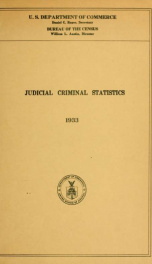United States. Bureau of the Census

The United States Census Bureau (officially Bureau of the Census as defined in Title 13 U.S.C. § 11) is the government agency that is responsible for the United States Census. It also gathers other national demographic and economic data. As part of the United States Department of Commerce, the Census Bureau serves as a leading source of data about America's people and economy.[1] The most visible role of the Census Bureau is to perform the official decennial (every 10 year) count of people living in the USA. One core result is to decide the number of seats each state is allowed in the House of Representatives.[1] The agency director is a political appointee selected by the President of the United States. The Constitution of the United States (Article I, section II) directs that the population be enumerated at least once every ten years and the resulting counts used to set the number of members from each state in the House of Representatives and, by extension, in the Electoral College. The Census Bureau now conducts a full population count every 10 years in years ending with a 0 (zero) and uses the term "decennial" to describe the operation. Between censuses, the Census Bureau makes population estimates and projections.[2] In addition, Census data directly affect how more than $300 billion per year in federal and state funding is allocated to communities for neighborhood improvements, public health, education, transportation and much more. The Census Bureau is mandated with fulfilling these obligations: the collecting of statistics about the nation, its people, and economy. The Census Bureau's legal authority is codified in Title 13 of the United States Code. In addition, the Census Bureau also conducts surveys on behalf of various Federal Government and local government agencies on topics such as employment, crime, health, consumer expenditures, and housing. Within the bureau, these are known as "demographic surveys" and are conducted perpetually between and during decennial (10-year) population counts. The Census Bureau also conducts economic surveys of manufacturing, retail, service, and other establishments and of domestic governments. From 1790 to 1840, the census was taken by marshals of the judicial districts.[3] The Census Act of 1840 established a central office[4] which became known as the Census Office. Several acts followed revising and authorizing new censuses, typically around the 10 year intervals. In 1902 the temporary Census Office was moved under the Department of Interior, and in 1903 it was renamed the Census Bureau under the new Department of Commerce and the Interior. The department was intended to consolidate overlapping statistical agencies, but Census Bureau officials were hindered by their subordinate role in the department.[5] An act around 1920 changed the date and authorized manufacturing censuses every 2 years and agriculture censuses every 10 years.[6] In 1929, a bill was passed mandating that the House of Representatives be reapportioned based on the results of the 1930 census.[6] In 1954, various acts were codified into Title 13 of the US Code.[7] By law the Census Bureau must count everyone and submit state population totals to the U.S. President by December 31, 2010. States within the Union would then receive the results the spring of the following year. Many federal, state, local and tribal governments use census data to: Business also has many uses for census data, as listed; The United States Census Bureau is committed to confidentiality and guarantees non-disclosure of any addresses or personal information related to individuals or establishments. Title 13 of the U.S. Code establishes penalties for the disclosure of this information. All Census employees must sign a sworn affidavit of non-disclosure prior to employment. The Census Bureau can not share responses, addresses or personal information with anyone including United States or foreign government and law enforcement agencies such as the IRS or the FBI or Interpol. "Providing quality data, for public good, -while respecting individual privacy and, at the same time, protecting confidentiality- is the Census Bureau's core responsibility," says Arnold Jackson, chief operating officer for the US Census. "Keeping the public's trust is critical to the Census's ability to carry out the mission as the leading source of quality data about the Nations people and economy." Only after 72 years does the information collected become available to other agencies or the general public. Since 1903, the official census-taking agency of the United States government has been the Bureau of the Census. The Census Bureau is headed by a Director, assisted by a Deputy Director and an Executive Staff composed of the associate directors. In April 2009, President Barack Obama nominated Robert M. Groves to head the Census Bureau. The Census Bureau has been headquartered in Suitland, Maryland since 1942. A new headquarters complex was completed in 2007 and supports over 4,000 employees.[8] The Bureau also operates regional offices in 12 cities: Boston, New York City, Philadelphia, Detroit, Chicago, Kansas City, Seattle, Charlotte, Atlanta, Dallas, Denver, and Los Angeles. The National Processing Center is located in Jeffersonville, Indiana. Additional temporary processing facilities are used to facilitate the decennial census, which employs more than a million persons. The cost of the 2000 decennial census was US$4.5 billion. During the years just prior to the decennial census, parallel Census offices, known as "Regional Census Centers" are opened in the 12 field office cities. The decennial operations are carried out expressly from these facilities. The Regional Census Centers will oversee the openings and closings of smaller "Local Census Offices" within their collection jurisdictions. The Census Bureau also runs the Census Information Center cooperative program that involves 58 "national, regional, and local non-profit organizations." The CIC program aims to represent the interests of underserved communities.[9] The United States Census Bureau has four official regions, with nine official divisions. The 1890 census was the first to use the electric tabulating machines invented by Herman Hollerith.[10] For 1890-1940 details, see Truesdell, Leon E. (1965). The Development of Punch Card Tabulation in the Bureau of the Census, 1890-1940: With outlines of actual tabulation programs. US GPO. . In 1946, knowing of the Bureau's funding of Hollerith and, later, Powers, John Mauchly approached the Bureau about early funding for UNIVAC development.[11] A UNIVAC I computer was accepted by the Bureau in 1951.[12] In order to reduce paper usage and reduce payroll expenses, 500,000 handheld computers (HHC's) were used for the first time in 2009 during the address canvassing portion of the 2010 Dicentennial Census Project. Projected savings are over $1 Billion dollars.[13] The further implementation of advanced computer systems in the planning for the 2020 Census provide major challenges for an upgrade in the technological broadening of Census protocol. A survey is a method of collecting and analyzing social, economic, and geographic data. It provides information about the conditions of the United States, states, and counties. Throughout the decade between censuses, The Bureau of the Census is continually conducting surveys to produce a general view and comprehensive study of the United States' social and economic conditions. Staff from the Current Surveys Program conduct ongoing and special surveys about people and their characteristics. A network of professional field representatives gathers information from a sample of households, responding to questions about employment, consumer expenditures, health, housing, and other topics. Surveys Conducted in between decades. The Census Bureau collects information in many other surveys and provides the data to the survey sponsor for release. These sponsors include:
do you like this author?
What readers are saying
What do you think? Write your own comment on this book!
write a commentWhat readers are saying
What do you think? Write your own comment on this author!
write a commentBook list

Report on the population, industries, and resources of Alaska
Series:
Unknown
Year:
Unknown
Raiting:
5/5
26
Show more
add to favoritesadd In favorites

Report on the forests of North America, exclusive of Mexico
Series:
Unknown
Year:
Unknown
Raiting:
3/5
10 14
Show more
add to favoritesadd In favorites
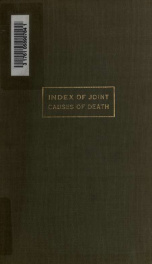
Index of joint causes of death : showing assignment to the preferred title of the international list of causes of death when the two causes are simultaneously reported
Series:
Unknown
Year:
Unknown
Raiting:
5/5
"Detailed international list of causes of death": p. 9-14 14
Show more
add to favoritesadd In favorites
Book list

Report on the population, industries, and resources of Alaska
Series:
Unknown
Year:
Unknown
Raiting:
5/5
26
Show more
add to favoritesadd In favorites

Report on the forests of North America, exclusive of Mexico
Series:
Unknown
Year:
Unknown
Raiting:
3/5
10 14
Show more
add to favoritesadd In favorites

Index of joint causes of death : showing assignment to the preferred title of the international list of causes of death when the two causes are simultaneously reported
Series:
Unknown
Year:
Unknown
Raiting:
5/5
"Detailed international list of causes of death": p. 9-14 14
Show more
add to favoritesadd In favorites
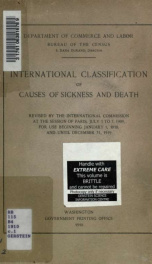
International classification of causes of sickness and death
Series:
Unknown
Year:
Unknown
Raiting:
3.5/5
14
Show more
add to favoritesadd In favorites
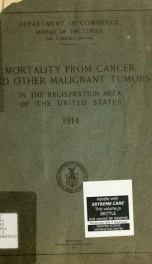
Mortality from cancer and other malignant tumors in the registration area of the United States, 1914
Series:
Unknown
Year:
Unknown
Raiting:
3/5
14
Show more
add to favoritesadd In favorites

Uniform accounts for systems of water supply
Series:
Unknown
Year:
Unknown
Raiting:
4/5
Book digitized by Google from the library of the University of Michigan and uploaded to the Internet Archive by user tpb. At head of title: Department of commerce and labor. Bureau of the census. E. Dana Durand, director In the preparation of this scheme ... the Bureau of the census was presented by Mr. Le Grand Powers. cf. p. 5
Show more
add to favoritesadd In favorites

Standard nomenclature of diseases and pathological conditions, injuries, and poisonings for the United States
Series:
Unknown
Year:
Unknown
Raiting:
4.5/5
Show more
add to favoritesadd In favorites

United States life tables, 1890, 1901, 1910, and 1901-1910. Explanatory text, mathematical theory, computations, graphs, and original statistics, also tables of United States life annuities, life tables of foreign countries, mortality tables of life insur
Series:
Unknown
Year:
Unknown
Raiting:
2.5/5
Book digitized by Google and uploaded to the Internet Archive by user tpb. At head of title: Department of Commerce. Bureau of the Census. Sam L. Rogers, director
Show more
add to favoritesadd In favorites

Census of Manufactures, Mines and Quarries, Petroleum and Natural Gas
Series:
Unknown
Year:
Unknown
Raiting:
4/5
Book digitized by Google from the library of the University of Michigan and uploaded to the Internet Archive by user tpb.
Show more
add to favoritesadd In favorites

Statistical Directory of State Institutions for the Defective, Dependent ...
Series:
Unknown
Year:
Unknown
Raiting:
4.5/5
Book digitized by Google and uploaded to the Internet Archive by user tpb.
Show more
add to favoritesadd In favorites

Statistical view of the United States, embracing its territory, population - white, free colored, and slave - moral and social condition, industry, property, and revenue; the detailed statistics of cities, towns and counties; being a compendium of the sev
Series:
Unknown
Year:
Unknown
Raiting:
3/5
40
Show more
add to favoritesadd In favorites

Thirteenth census of the United States taken in the year 1910
Series:
Unknown
Year:
Unknown
Raiting:
4.5/5
Show more
add to favoritesadd In favorites

Thirteenth census of the United States taken in the year 1910 : abstract of the census : statistics of population, agriculture, manufactures and mining for the United States, the states, and principal cities : with supplement for California, containing st
Series:
Unknown
Year:
Unknown
Raiting:
3/5
Show more
add to favoritesadd In favorites

Telephones: 1907
Series:
Unknown
Year:
Unknown
Raiting:
4.5/5
Book digitized by Google and uploaded to the Internet Archive by user tpb. At head of title: Department of Commerce and Labor. Bureau of the Census. E. Dana Durand, Director. Special reports "Statistics concerning the physical equipment, service, and financial operations of the commercial and mutual telephone systems of the country and the independent and rural telephone lines for the year ending December 31, 1907. This is the second census of the telephone industry...taken since the Bureau of the Census was made a permanent office. The first census covered the year ending December 31, 1902...The statistics were collected and the report prepared under the supervision of Mr. William M. Steuart...Mr. T. Commerford Martin...prepared the portion of the report dealing with the technical features of the industry, with the assistance of Mr. Franklin H. Reed."
Show more
add to favoritesadd In favorites
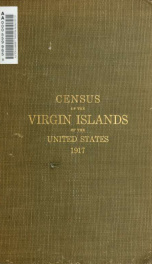
Census of the Virgin Islands of the United States, November 1, 1917
Series:
Unknown
Year:
Unknown
Raiting:
5/5
Show more
add to favoritesadd In favorites
What readers are saying
What do you think? Write your own comment on this author!
write a commentif you like United States. Bureau of the Census try:
readers also enjoyed
What readers are saying
What do you think? Write your own comment on this author!
write a commentGenre
if you like United States. Bureau of the Census try:
readers also enjoyed
Do you want to read a book that interests you? It’s EASY!
Create an account and send a request for reading to other users on the Webpage of the book!
